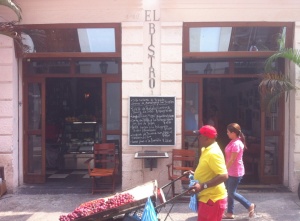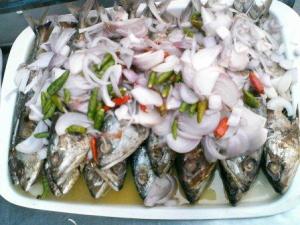My first trip to Cartagena Colombia was a last-minute one night, two day trip with my friend Farhan (we found return flights from Medellín for roughly $65 USD!), and my dining experience at El Bistro was worth the trip alone: not only was it my best meal in Cartagena; it was honestly my best restaurant meal to date, in all of my six plus months in Colombia! Continue reading ‘El Bistro Cartagena: My Best Meal in Colombia!’
 As part of the foodbuzz project food blog contest, my first challenge is to define myself as a food blogger, and to do that, there’s no easier way than to share how and why I started this adventure into ethnic cuisine! Continue reading ‘steamed fish chinese-style: another ethnic trick’
As part of the foodbuzz project food blog contest, my first challenge is to define myself as a food blogger, and to do that, there’s no easier way than to share how and why I started this adventure into ethnic cuisine! Continue reading ‘steamed fish chinese-style: another ethnic trick’
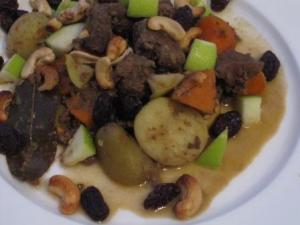 This dish (pronounced poy-key-kose) is another variation of slow cooked stew, the fruits, nuts and spices adding a bit more flavour than what you may find in the West.
This dish (pronounced poy-key-kose) is another variation of slow cooked stew, the fruits, nuts and spices adding a bit more flavour than what you may find in the West.
It is named after the three-legged iron potjie pot, originating in South Africa, but popular today in most of the southern countries. The pot retains a lot of heat, ideal for low maintenance cooking over a number of hours.
Every restaurant and home has their own recipe, most of them today using prepackaged spice mixes for this dish. You could do it with any type of curry spice, but when creating it for a restaurant in Namibia, the chef and I made this house recipe from scratch. Continue reading ‘the spice is right: Southern African potjiekos’
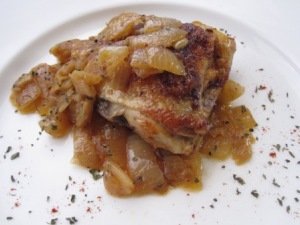 While preparing to create a new menu for a restaurant in Namibia, I saw that they regularly used mustard with some common packaged spices to flavour their meats. I immediately recalled a delicious meal I learned to make with a family in Dakar, Senegal, and decided to adapt it to give the restaurant an original dish in this part of the continent.
While preparing to create a new menu for a restaurant in Namibia, I saw that they regularly used mustard with some common packaged spices to flavour their meats. I immediately recalled a delicious meal I learned to make with a family in Dakar, Senegal, and decided to adapt it to give the restaurant an original dish in this part of the continent.
In French, the dish is known as ‘poisson trop cuit’, meaning overcooked fish. It gives it a super crispy texture, and the way the body is scored with little squares, you can easily pick them off one at a time, enjoying them with the savoury carmelized onion sauce, the mustard enhancing its sweetness. Continue reading ‘Crispy fish or chicken in African onion mustard sauce’
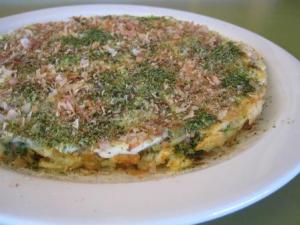 This will be a quick post, much like the dish, which can be thrown together in a matter of minutes.
This will be a quick post, much like the dish, which can be thrown together in a matter of minutes.
The only ingredients that I would say are standard for this recipe are flour, egg, and chopped cabbage; after that, you can go nuts throwing in leftover vegetables, pieces of meat, seafood, etc., and if you want it to taste Japanese, at least one ingredient with a Japanese flavour (such as dashi instead of water, bonito shavings (katsuobushi), or nori flakes). These items are super cheap in Japan, and can often be found in Chinese or other Asian supermarkets. Continue reading ‘okonomiyaki: savoury Japanese pancakes, any way you like them!’
 “In coming to Japan, I was really looking forward to catching up with my friend Kyle (he moved here from Toronto years ago). I had little expectations for learning opportunities, as it was very difficult to get anything organized in advance. But now that I’m here, everything has changed. After meeting me face to face, the same people who were apprehensive about planning things online are proud to take me into their homes and restaurants to share their cooking and culture! Each day has been full of lessons and learning, scurrying from one city to another. I’ve even had to turn people’s offers down after being double and triple-booked! It’s been more than three weeks here, and I’m wishing that I had more time. Here are a few of the highlights from my stay: Continue reading ‘borrowing from britain: japanese niku jaga’
“In coming to Japan, I was really looking forward to catching up with my friend Kyle (he moved here from Toronto years ago). I had little expectations for learning opportunities, as it was very difficult to get anything organized in advance. But now that I’m here, everything has changed. After meeting me face to face, the same people who were apprehensive about planning things online are proud to take me into their homes and restaurants to share their cooking and culture! Each day has been full of lessons and learning, scurrying from one city to another. I’ve even had to turn people’s offers down after being double and triple-booked! It’s been more than three weeks here, and I’m wishing that I had more time. Here are a few of the highlights from my stay: Continue reading ‘borrowing from britain: japanese niku jaga’
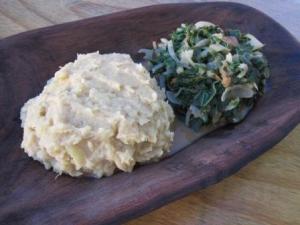 For Africa Day, I thought I’d post a recipe using one of the most common forms of cooking vegetables, roots, and pulses in Africa: the puree. I learned this variation of chiguinha from Lucia in Maputo, for which cassava (mandioca) root can also be used in place of the sweet potato (in Southern Africa, the common sweet potato has a pinkish skin, while the inside is white). Continue reading ‘Chiguinha: Mozambican sweet potato peanut puree’
For Africa Day, I thought I’d post a recipe using one of the most common forms of cooking vegetables, roots, and pulses in Africa: the puree. I learned this variation of chiguinha from Lucia in Maputo, for which cassava (mandioca) root can also be used in place of the sweet potato (in Southern Africa, the common sweet potato has a pinkish skin, while the inside is white). Continue reading ‘Chiguinha: Mozambican sweet potato peanut puree’
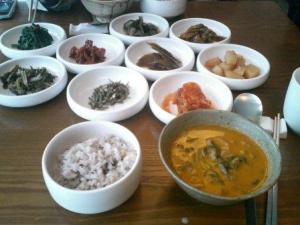 “I asked a Korean friend what a typical food day is like here. He said it would usually be similar for all three meals at home: it may include a meat dish like bulgogi (thin slices of beef and onion marinated in a mixture of garlic, sugar, soy sauce and sesame oil), but it’s always served with soup and rice as the main course, and kimchi on the side. Continue reading ‘Korean cucumber kimchi made quick’
“I asked a Korean friend what a typical food day is like here. He said it would usually be similar for all three meals at home: it may include a meat dish like bulgogi (thin slices of beef and onion marinated in a mixture of garlic, sugar, soy sauce and sesame oil), but it’s always served with soup and rice as the main course, and kimchi on the side. Continue reading ‘Korean cucumber kimchi made quick’
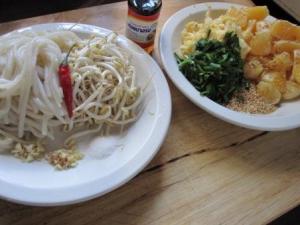 This beloved recipe is not from my travels in Thailand: I adapted it from a great cookbook, which I unfortunately don’t have the name of at this time (it’s packed away in Canada).
This beloved recipe is not from my travels in Thailand: I adapted it from a great cookbook, which I unfortunately don’t have the name of at this time (it’s packed away in Canada).
The combination of fresh ginger, juicy chunks of orange, and aromatic greens (either garlic greens, chives, or spring onions) creates another light, rejuvenating meal. Continue reading ‘refreshing orange and ginger Thai noodles’
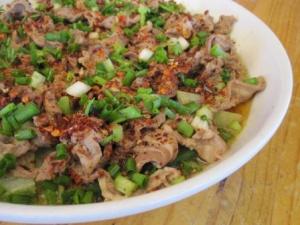 I arrived in Chengdu, Sichuan province, only a couple days after the big earthquake in 2008. I was expecting the place to be a mess, but was surprised to find so much in the city already running as usual (aside from moments when we’d feel a big aftershock, and people would scurry in a panic, down the apartment stairs and outside). I only mention the food briefly in my novel, mainly because I was fortunate enough to find a bible of a book on the cuisine, and after leafing through it a number of times, I spent most of my energy eating, rather than recording recipes (this is an exception). Continue reading ‘Spicy Sichuan ‘boiled meat’ from Chengdu, China’
I arrived in Chengdu, Sichuan province, only a couple days after the big earthquake in 2008. I was expecting the place to be a mess, but was surprised to find so much in the city already running as usual (aside from moments when we’d feel a big aftershock, and people would scurry in a panic, down the apartment stairs and outside). I only mention the food briefly in my novel, mainly because I was fortunate enough to find a bible of a book on the cuisine, and after leafing through it a number of times, I spent most of my energy eating, rather than recording recipes (this is an exception). Continue reading ‘Spicy Sichuan ‘boiled meat’ from Chengdu, China’
 “Before I caught the bus here, Mama Zoe in Athens gave me a big, strong hug, tears running down her face as I left the apartment. This was followed by her screaming bye from the third floor balcony, waving as I walked down the street. Continue reading ‘better than bruschetta? delightful greek dakos’
“Before I caught the bus here, Mama Zoe in Athens gave me a big, strong hug, tears running down her face as I left the apartment. This was followed by her screaming bye from the third floor balcony, waving as I walked down the street. Continue reading ‘better than bruschetta? delightful greek dakos’
 “After spending weeks trying to find someone to teach me to cook in Morocco, I finally got lucky when Youssef, a new member to the hosting network, created a profile stating he’s a chef in Marrakech, happy to share his passion for cuisine with others! Continue reading ‘moroccan tagine kefta (without the tagine)’
“After spending weeks trying to find someone to teach me to cook in Morocco, I finally got lucky when Youssef, a new member to the hosting network, created a profile stating he’s a chef in Marrakech, happy to share his passion for cuisine with others! Continue reading ‘moroccan tagine kefta (without the tagine)’
 “I’m having fun here in Athens! Marina is like my big sister, bossy and protective at the same time. And our friend Giota is like my little sister, playful and always looking for attention. Marina’s mom Zoe cooks very traditional recipes for me, with a focus on learning things that are ‘not Turkish’ Continue reading ‘stifado: home-style greek food fit for the gods’
“I’m having fun here in Athens! Marina is like my big sister, bossy and protective at the same time. And our friend Giota is like my little sister, playful and always looking for attention. Marina’s mom Zoe cooks very traditional recipes for me, with a focus on learning things that are ‘not Turkish’ Continue reading ‘stifado: home-style greek food fit for the gods’
sweet tunisian lamb ragu
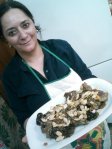 After a friend asked me to prepare this dish again for her last meal in Namibia, I thought I’d share one of the many recipes that didn’t make it into the pages of Not All Men Are Monsters, but will be presented in the next book I write, dedicated to ethnic food and culture. Continue reading ‘sweet tunisian lamb ragu’
After a friend asked me to prepare this dish again for her last meal in Namibia, I thought I’d share one of the many recipes that didn’t make it into the pages of Not All Men Are Monsters, but will be presented in the next book I write, dedicated to ethnic food and culture. Continue reading ‘sweet tunisian lamb ragu’
 Mozambicans in Maputo are the most vegetable-aware Africans I have met: they would tell me all about the nutritional value of eating and cooking them while learning in Mercado Janeta, and leafy greens are a staple in the local diet (a friend told me that many people are actually forced to become quasi-vegetarians, because they can’t afford to purchase more than salads and bread for meals). Continue reading ‘mozambican leafy greens in coconut and peanut sauces’
Mozambicans in Maputo are the most vegetable-aware Africans I have met: they would tell me all about the nutritional value of eating and cooking them while learning in Mercado Janeta, and leafy greens are a staple in the local diet (a friend told me that many people are actually forced to become quasi-vegetarians, because they can’t afford to purchase more than salads and bread for meals). Continue reading ‘mozambican leafy greens in coconut and peanut sauces’
 “I’m learning a lot these days in a home-style Korean restaurant (though I’m a bit tired from standing on my feet all day in sandals!). Jen the journalist was given an assignment to write an article about Korean food in Seoul. She got on really well with Jungtae Lee and his wife, and put us in contact. Continue reading ‘galbi chim: korean short rib stew’
“I’m learning a lot these days in a home-style Korean restaurant (though I’m a bit tired from standing on my feet all day in sandals!). Jen the journalist was given an assignment to write an article about Korean food in Seoul. She got on really well with Jungtae Lee and his wife, and put us in contact. Continue reading ‘galbi chim: korean short rib stew’
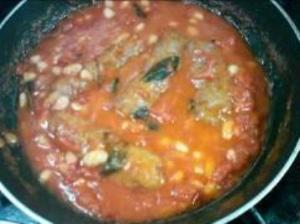 “Terzo Cerchio is the restaurant in Istia D’Ombrone where I spent a week learning about simple Tuscan food (simple in the preparation using minimal ingredients, but of the highest quality). In addition to making pasta from scratch, sauces loaded with fragrant mushrooms, and vegetable side dishes and appetizers beyond crostini and bruschetta, I learned a lot about the local eating customs. Continue reading ‘simply italian: fagioli all’uccelletto’
“Terzo Cerchio is the restaurant in Istia D’Ombrone where I spent a week learning about simple Tuscan food (simple in the preparation using minimal ingredients, but of the highest quality). In addition to making pasta from scratch, sauces loaded with fragrant mushrooms, and vegetable side dishes and appetizers beyond crostini and bruschetta, I learned a lot about the local eating customs. Continue reading ‘simply italian: fagioli all’uccelletto’
 When looking at photos of African food, you may wonder what the pile of white stuff resembling mashed potatoes is: this is one of the main staples of Sub Saharan African cuisine, and we call it ‘xima’ in Mozambique (pronounced she-ma).
When looking at photos of African food, you may wonder what the pile of white stuff resembling mashed potatoes is: this is one of the main staples of Sub Saharan African cuisine, and we call it ‘xima’ in Mozambique (pronounced she-ma).
Its name changes (from fufu in West and Central Africa to pap in Southern Africa, to nshima or ugali in East Africa, etc) as often as the methods of cooking differ (it is beaten or stirred in different ways, giving it a different texture as more or less air in it allows it to fluff up or clump together). I find the Namibian and Mozambican methods easier to prepare, as they’re not as physically straining as in West Africa, but are much heavier to eat at the same time. Continue reading ‘xima/pap: sub saharan africa’s staple food’
fast mozambican meat marinade
 The days of $1 USD quarter chicken lunches served with salad and chips are gone in Maputo, as are a couple of my favourite restaurants where I used to eat it. The price of chicken seems to have sky rocketed here, with many of the places selling the same dish, with less flavour, for double or triple the price. In Mercado Janet, to be able to still sell ‘frango’ at an affordable 30 meticais ($1 USD), the bird has to be cut up into at least 12 pieces (you can see how small it is in the accompanying picture, where half the plate is comprised of onion tomato sauce). Continue reading ‘fast mozambican meat marinade’
The days of $1 USD quarter chicken lunches served with salad and chips are gone in Maputo, as are a couple of my favourite restaurants where I used to eat it. The price of chicken seems to have sky rocketed here, with many of the places selling the same dish, with less flavour, for double or triple the price. In Mercado Janet, to be able to still sell ‘frango’ at an affordable 30 meticais ($1 USD), the bird has to be cut up into at least 12 pieces (you can see how small it is in the accompanying picture, where half the plate is comprised of onion tomato sauce). Continue reading ‘fast mozambican meat marinade’
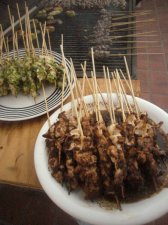 This is by far my favourite street food in Jakarta. You can purchase ten sticks dripping in peanut sauce for less than a dollar, and they even come with a tasty rice-based side dish called lontong (see Mega’s recipe in the comments below!).
This is by far my favourite street food in Jakarta. You can purchase ten sticks dripping in peanut sauce for less than a dollar, and they even come with a tasty rice-based side dish called lontong (see Mega’s recipe in the comments below!).
For me, the key to a great satay (and what often separates the masters from the rest) is the smoothness of the sauce. Continue reading ‘bumbu kacang: Indonesian Peanut Satay’
My cuisine gurus
Here you will find photos of almost everybody who taught me to cook between 2007 and 2009, organized by countries with descriptions when you mouse over the images, and links to their websites if available. If you see something you like, post a comment and I’ll try to share recipes as soon as possible! Continue reading ‘My cuisine gurus’
Vegetables, Health and Nutrition
Health and nutrition are very important aspects of food culture, and I’ve tried to learn as much as possible about different ways to prepare delicious vegetables, pulses, etc., so that meat eaters may be encouraged to add more of them to their repertoire.
And vegetarians/vegans, keep reading
